Blogging About My Age
One year ago today I wrote about turning 30. I challenged myself to be less cynical (still working on it) and recounted how strange the previous year had been. At the time I thought it was one of the few instances I had blogged about my age, and I thought well worth it given the pseudo-momentousness of ending my twenties. Going through some old pieces, though, I found I had written about my age before.
Before the candler blog, almost all of my writing was done at poritsky.com/blog. And before that I kept a blog on MySpace. Most of those pieces, including the one I’m writing about here, got transferred over to my site, thankfully, since MySpace’s blogs have disappeared from the web.
Those early pieces are what I would call more bloggy blogging. I’ve always tried to treat the candler blog like an outlet for published articles as opposed to an ongoing personal journal.1 I’m proud to call this site a blog; the writing, I hope, speaks for itself.
That I’ve held this site back from going fully diaristic came to mind when I found a piece from June of 2007, “Tired of my age.” Now this is some bloggy blog writing. Here it is in full:
I’m tired of people asking my age. I recognize that I’m a kid. People hear 22 they think I should be doing kegstands between exams. Professionally, this is becoming an issue, but only when people ask. I’ve been blessed with a thick beard so the question rarely comes up. But the most annoying iteration of this confusion, the absolute worst, is when women ask. Should I start lying? I tend to hang out with 30somethings, which is fine, and they like hanging out with me, until the issue of years comes up. They’ll ask my age or they’ll reference things I know nothing of, baseball players from “when we were kids” only “when we were kids” happens to be 10 years apart. Ah well, I guess everyone thinks they were born 10 or 20 years late. Anyhow, who cares about those people anyway. Next time they ask me my age I’ll just have to say I’ve got a better shot of seeing 2060 than you, babe.
Pretty sure I wrote that after a thirty-something rejected me at a rooftop party.
I would never publish something like that now, anywhere. Why is that, though? Sure, that last line kinda makes me cringe, but so what? It’s out there and I’m not going to scrub it from the web.
I wonder how much of my reticence to publish anything like that piece has to do with my growing older and how much has to do with the web growing up. Maybe it’s not just that my years have made a bit more hesitant to fling every last idea out there; maybe it’s that there are so many things on the web nowadays it feels silly to throw my little fit into the mix. At best it will get lost; at worst I’ll be harangued by mobs of commenters rubbed the wrong way by my words. And so while pondering the question “What’s the point?” I’d write nothing.
I’m reminded of something Kanye West said last year when Steve McQueen asked him how he was able to express himself in the way that he does:
I just close my eyes and act like I’m a 3-year-old. [laughs] I try to get as close to a childlike level as possible because we were all artists back then. So you just close your eyes and think back to when you were as young as you can remember and had the least barriers to your creativity.
Now that I’m 31, I kind of wish I had the fool-hardiness of my 22 year-old self, whining about my age because my site gave me the opportunity to vent. And when I think back to being even younger, when the world seemed so huge and anything seemed possible…2 that’s something I’d like to bring to my writing. To all of my work, really.
But now I’m just some guy, blogging about his age. And it kinda feels great.
-
That “blog” is right there in the name is only because I couldn’t get the other “candler” URLs I wanted, so I appended “blog” and started writing. ↩︎
-
In elementary school I was active in the after-school program, Young Astronauts. I wanted to be an astronaut and believed that one day we’d all go to the moon and bring back rocks to show our friends, as if on vacation. ↩︎
#buysmall Newsletter
#buysmall is a very cool new newsletter from the folks behind Cotton Bureau. The idea is to spotlight the wares of some pretty neat small businesses. Here’s how they describe it in the first edition:
#buysmall is our way of shining a light on the interesting, clever, and/or exceptional folks who are in this fight, too. Business isn’t a zero-sum game. It’s a great big world out there, room enough for all of us, and when we help each other, we help ourselves.
I love the pennants they showed off from Oxford Pennant, and I’m kind of lusting after this Grovemade Walnut Monitor Stand. This is a no-brainer instant subscribe for me.
Marco Arment and Context
Marco Arment is many things to many people. He’s a podcaster of great energy, one of the current best in the business. He’s an independent iOS developer who made Instapaper, an early hit on the iPhone and then the iPad, and currently develops the popular podcasting client, Overcast. He helped build Tumblr, which would ultimately be bought by Yahoo for over $1 billion.
Marco is a tech success story. He is a celebrity. When the media treats him like one, though, it catches him off guard. I don’t understand why.
On Sunday, Marco published “Don’t order the fish,” a piece that takes Apple to task for Apple Music. I’m going to quote Marco here directly. This bit comes after praising Apple’s rock-solid sync services, like push notifications and iCloud Photo Library. Then this:
But the iTunes Store back-end is a toxic hellstew of unreliability. Everything that touches the iTunes Store has a spotty record for me and almost every Mac owner I know.
And the iTunes app itself is the toxic hellstew. iTunes has an impossible combination of tasks on its plate that cannot be done well. iTunes is the definition of cruft and technical debt.
And later:
With the introduction of Apple Music, Apple confusingly introduced a confusing service backed by the iTunes Store that’s confusingly integrated into iTunes and the iOS Music app (don’t even get me started on that) and partially, maybe, mostly replaces the also very confusing and historically unreliable iTunes Match.
So iTunes is a toxic hellstew of technical cruft and a toxic hellstew of UI design, in the middle of a transition between two partly redundant cloud services, both of which are confusing and vague to most people about which songs of theirs are in the cloud, which are safe to delete, and which ones they actually have.
One could argue that the above takes Marco out of context; that the only way to get the full impact of Marco’s piece is to read it in full. That’s only sort of true, because context often runs deeper than a single article.
Today, CNBC’s Squawk Alley did a segment on Marco’s piece, attributing “toxic hellstew” to him. This seems to be bugging Marco.
Marco has updated his article to include a link to a catchy song by Jonathan Mann about the 2014 WWDC keynote. One line Mann picked up on was Tim Cook quoting the headline of a ZDNet article by Adrian Kingsley-Hughes: “Android fragmentation turning devices into a toxic hellstew of vulnerabilities.” Cook saying the line became something of a meme for a short while, most popularly in Mann’s song.
I follow Apple nerd stuff pretty closely, so I understood the reference. The thing is: it doesn’t much matter who invented the term, Marco absolutely just tied it to both Apple and himself. “iTunes is a toxic hellstew of technical cruft and a toxic hellstew of UI design” is absolutely something Marco Arment said. It sounds like he meant it and anyone, in any form of media, can pick up his words and run with them.
This isn’t the first time Marco’s words have taken on extra meaning. Back in January he published “Apple has lost the functional high ground,” a piece that blew up overnight and resulted in a mea culpa the following day. That piece, turns out, offers some great advice for Marco today:
I now need to write everything with the fear that any hastily written article might end up on TV, with the most extreme word in the article singled out with my name on it forever.
Yep.
I understand Marco’s dilemma. He’s opinionated and loves blogging. But he sometimes acts oblivious to his standing in the tech community. His success has bred him an audience; his words hold more weight because of his status. I have trouble believing he didn’t know there would be an “Influential iOS developer Marco Arment says…” narrative thread others would pick up on from his post.
Back when the “functional high ground” thing flared up, I recall Marco discussing on his podcast, ATP, the idea that people who listen to the show and have been reading him for years have a better understanding of what that article was about. That’s true, but it’s irrelevant. The written word is amazing because it can be so easily quoted. Authors can be held accountable on a fairly even playing field. No inflection, no body language; just words.
It would be nice if everyone had the context they needed to understand the author’s intent, but that’s not reasonable. I know Marco’s work extremely well, but that’s years worth of material that I’ve slowly incorporated into my own knowledge. I’ve peppered this piece with a few tiny zingers that only those who follow Apple and/or Marco may understand, but that context doesn’t form the bedrock of this piece.
I love reading and listening to Marco. I hope he never slows down his creative output. I just think he shouldn’t be surprised when people take his words at face value, which is ultimately all they’re worth.
Apple Music is My Dream Streaming Service

Apple Music
Jim Dalrymple, yesterday, in a post titled “Apple Music is a nightmare and I’m done with it”:
I had high hopes for Apple Music. I really wanted it to work and become my default music streaming service, but after the problems I’ve experienced over the last couple of weeks, I’m disabling it altogether.
His piece is a scathing indictment of the service. Dalrymple says he is “missing about 4,700 songs from my library with little hope of getting them back.” That sucks big time. My heart goes out to him.
I have tried to replicate Jim’s problems, but I can’t. My guess is that the culprit is his transitioning from Beats Music to Apple Music, which I never did. So maybe I dodged a bullet there.
As to where his 4,700 songs went: that’s scary and I want to know more about it. I understand that Jim is a bit beleaguered at this point, but I really wish he would go into more detail about how he experienced his songs going missing. Here’s what he tells us:
Over the weekend, I turned off Apple Music and it took large chunks of my purchased music with it. Sadly, many of the songs were added from CDs years ago that I no longer have access to. Looking at my old iTunes Match library, before Apple Music, I’m missing about 4,700 songs.
It’s Apple’s fault that these services are so difficult to talk about, but I don’t get what Jim’s iTunes Match library is in this context. Is he looking at a smart playlist? Are they still in his library but showing up with dreaded exclamation points? What I think is important for Apple Music and iTunes users to learn from Jim’s troubles is how to know what you don’t have. Unless I knew which tracks to look for, I don’t know that I’d know what I was missing. Right now, though, I think this should give us all huge pause before turning off Apple Music. I hope Jim (or anyone) can shed some light on what went wrong and how to prevent it.1
Now, all that said, I do want to share my experience with Apple Music. I absolutely love it. If Apple Music is Jim’s nightmare, it’s my dream. For me it’s the perfect mix of my own musical tastes (my 98+ GB library that I’ve been building since at least 2002) and an infinite library of songs brought to my attention by others. That integration with my own library is crucial, and it’s really what I missed with Spotify and Rdio, the only other streaming services I ever really tried.
I’ll concede that there is a learning curve to using Apple Music in conjunction with your own library. The highest point of friction for me is search, which is basically the only tool I use to get to music I want. You can search either Apple Music or My Music. It takes some getting used to, but I think of it like this:
- My Music is your iTunes library
- Apple Music is all2 other music; it’s the streaming service
There are things in my library3 that I know will never be available in Apple Music, like my single track of the entirety of Radiohead’s OK Computer that I sometimes like to listen to even though I have the full album as tracks and it sounds just fine. I should mention that I’ve been an iTunes Match subscriber since February 2013, so my entire library was already in Apple’s cloud. Flipping on Apple Music created zero friction for me.
Since subscribing to the streaming service, I’ve been adding music to my library left and right, mostly while listening to Beats 1 (sometimes by way of Connect). I hear something I like and I either add it to “My Music” or put it into a playlist. That last part, adding songs from the Apple Music to my playlists, is pretty amazing. I have a playlist for running4 that went stagnant for months. Now I add music to it a few times a week. I love that I didn’t have to recreate that playlist in Apple Music with matched tracks or anything; I get to have the best of both worlds.
Jim Dalrymple is one of the most respected writers in the Apple and tech communities. A one-word blog post from him (usually “Nope.” or “Yep.”) holds more weight than the sum total of all Apple “analysis” out there, so a blistering takedown from him is not something to be dismissed. I hope Apple does right by him and other users affected by any bugginess.
I just want to put it out there that Apple Music is the best streaming service I have ever used. My guess is that there are a lot of people out there who have used it without any issues. But that’s not much of a story.
-
Back up your libraries, folks. I use Backblaze. Use this link to sign up for it and I get a little kickback. ↩︎
-
I know it’s not all music ever. I’m being hyperbolic, but the massiveness of streaming libraries feels like every song ever to me. Pulling the hyperbole back and saying something like “most other music” feels inaccurate too. ↩︎
-
Ahem, My Music, see above where I said Apple doesn’t make it easy to talk about this stuff. ↩︎
-
I really don’t mean to talk about running this much. It just happens… ↩︎
Day One as Running Diary
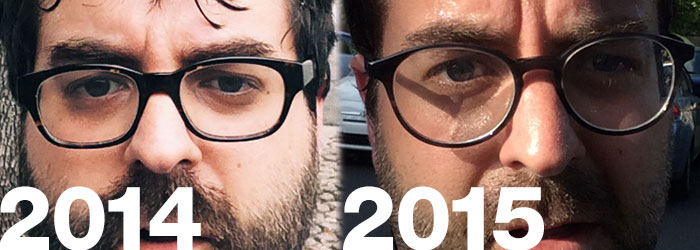
When I wrote about running with my Apple Watch two weeks ago, I mentioned in a footnote that “entering run notes into Day One” was a key reason I preferred keeping my phone on me. I’d like to elaborate on that just a small bit.
In case you don’t know, Day One is a journaling app for iOS and Mac. You can file your writings by date, tag posts, add a photo and even add numerous bits of metadata to each piece. Your location, the weather, what music you’re listening to and whether or not you were walking, driving or sitting still can all be attached to each entry. It’s like your own private little blog (it can even become a public blog if you like).1
While I have done plenty of writing in Day One, lately I tend to do most of my writing either in a Field Notes memo book or in Ulysses on my Mac. But Day One is still one of my most used apps. I’ve been using it for over a year2 as a running diary. Every time I run I create an entry with a photo (usually a selfie) and a few words about how I felt during the run. I always add the tag “Running” to these so I can keep track.
Now, RunKeeper can hold all of this information pretty well too. Each run can have a photo and a note attached to it. I tend to upload photos to RunKeeper as well, and will sometimes add a short note. The truth is that, while RunKeeper does an incredible job displaying and tracking data related to exercise, it’s not great at displaying anything personal. It’s a colder app, which is fitting since it needs to be as reliable as a stopwatch. But for storing and retrieving how running makes me feel I need something more personal, more beautiful. Day One fits the bill.
Here are screen grabs of what my Day One “Timeline” (left) and “Photos” (right) views look like today.
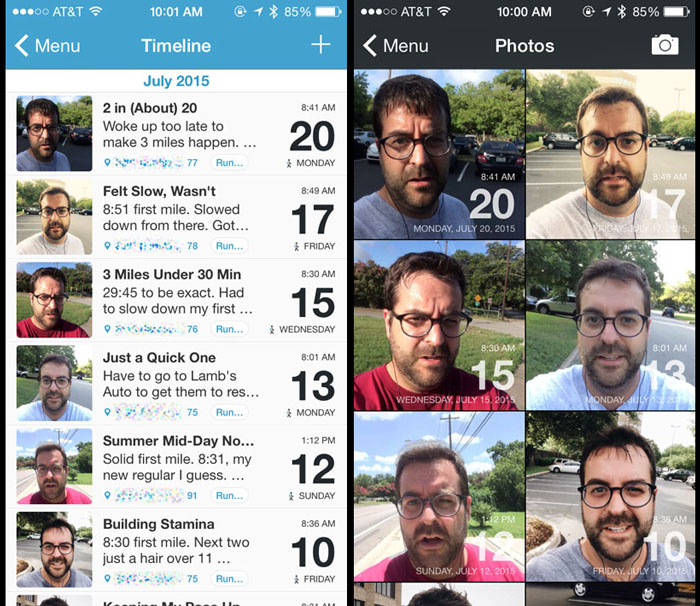
Inside Day One
Somewhere around the end of my run, I take a photo of myself. I may use filters in VSCO Cam, but more often I’ve been enjoying Apple’s built-in photo filters. As I cool down I create a new Day One photo entry and tap out a few notes.3 I may include my split times, or I may just talk about how I feel and what in my life may have caused the run to go the way it did (e.g. too little sleep, a heavy meal). Sometimes it has almost nothing to do with running, as when I spotted a dog that had ventured out of his owner’s yard and I helped him get back home.
This is where Day One really shines over something like RunKeeper. I run for many reasons; going faster and further are only a small part of that. Running is now part of my routine. It’s part of (most of) my days. There is a macro view of the thoughts I have while running and what the long-term effects it has on my health and demeanor that Day One allows me to track. No other tool comes close.
-
When I get the urge to tweet something that I really shouldn’t, I type it into Day One and tag it as “Untweet.” I like to think this has kept me out of more than a few shouting matches. ↩︎
-
First running entry: November 15, 2013. ↩︎
-
Day One also offers an excellent Watch app that allows me to pre-populate a post with a “Running” tag and the most recent photo. I don’t really use this though as I’m so used to actually typing out the entry as I create it. ↩︎
The Internet Sucks: A Reading List
In the past week (and then some) I’ve read so many stories that have done an excellent job articulating something I’ve been feeling for awhile now: the Internet sucks, and this is a new thing. I’ve tried to put this into words before, but the below articles do a better job.
The Internet is a vast landscape, yet all the same garbage bubbles up to the top these days. I don’t have any answers, but I do know it’s something we should be vigilant about. The web is too important to give up on. So here’s a reading list enumerating where we are today.
“Self Referential” by Gabe Weatherhead:
It’s obvious that publishing original content is a fading career opportunity and is being replaced by micro blogs such as Medium, Twitter and even Instagram. Not only do I think these are replacing individual blogs, such as this site, but I believe they are actively speeding the demise of original work.
“The Web We Have to Save” by Hossein Derakhshan:
There’s no question to me that the diversity of themes and opinions is less online today than it was in the past. New, different, and challenging ideas get suppressed by today’s social networks because their ranking strategies prioritize the popular and habitual.
“Escaping the new media cargo cult” by David Moldawer:
Whether you blame Facebook, Buzzfeed, HuffPo, or “algorithms,” the new media landscape has grown a big fat mainstream of its own. Not at one particular site, but in the sense of a particular mechanic of creative expression: tailored for clicks, pasteurized, grabby. The long tail of odd and authentic content is bigger than ever, but if you find your content the way most people do, through the algorithmically warped suggestions in your social media feeds, the stuff you stumble onto feels less like writing and more like wordage, a sort of tips-and-tragedies lorem ipsum.
“The trolls are winning the battle for the Internet” by Ellen Pao:
The Internet started as a bastion for free expression. It encouraged broad engagement and a diversity of ideas. Over time, however, that openness has enabled the harassment of people for their views, experiences, appearances or demographic backgrounds. Balancing free expression with privacy and the protection of participants has always been a challenge for open-content platforms on the Internet. But that balancing act is getting harder. The trolls are winning.
It’s Friday, so let’s end on a high note. Here’s a link to the instructions for the Penicillin, a cocktail my pal Noah turned me on to with a tweet. And here’s a video of its inventor, Sam Ross, demonstrating how to properly make it. The Internet doesn’t always suck, it seems.
{% youtube QgWoWghpUe4 %}
Bottoms up.
My First Field Notes
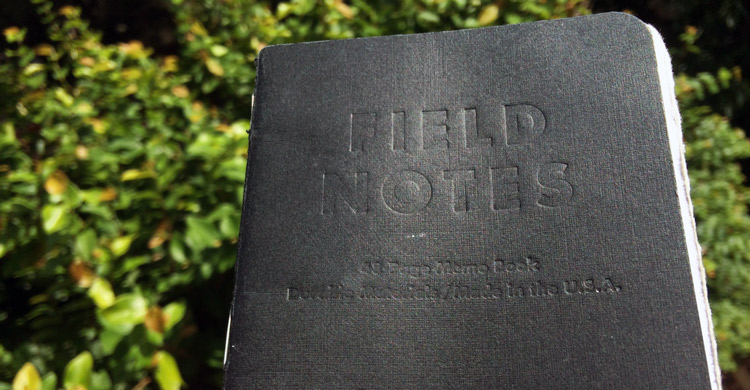
My First Field Notes
Last night I decided to tidy up my collection of Field Notes memo books. For a few years now I’ve kept one in my back pocket everywhere I go. Even if most days I don’t grab for it, I’m happy to have it there just in case.
After organizing my unused and sealed books, I went to put my filled up books in order.1 With few exceptions, almost every memo book I’ve written in has functioned as a sort of ongoing journal. To-do lists, creative pieces and work-related notes are often mixed in with more diaristic writing, but there is certainly an order to the books.
While flipping through pages to find the dates they were started and finished2 last night, I came across my first Field Notes memo book. I actually remember picking up that first three-pack, a limited edition Raven’s Wing from 2010, at McNally-Jackson, one of the great NYC book stores, long before I knew that these little notebooks would become pined after by collectors.3
I was surprised to find a notebook that actually said flat out that it was the first of the collection. When I opened up this little black book, there it was staring me in the face. My first Field Notes. An occasion worth calling out back then, apparently.
The next thing that surprised me was how specific the entry was about my relationship to digital tools, and how excited I seemed to be to be putting pen to paper once again. I had no idea, back in 2011, that writing in Field Notes would become a habit. But it has.
So I thought it would be fun to post the first thing I ever wrote in a Field Notes here on the candler blog. This was never supposed to see the light of day, but I rather like reading it again four years down the line. I wonder what other little nuggets are hidden within my collection of little filled notebooks.4 So here it is: what a twenty-six year-old version of myself thought about writing his thoughts out by hand.
3/2/11
Picked up my first Field Notes pack today. I’m not positive, but I believe this is my first notebook purchase since the iPad. Most of my writing has moved to an all digital format, something I’ve dreamed of from a young age. I had a Palm, and always wanted to try an iPaq because it seemed like a palm sized computer. But nothing compares to the ubiquity of the iPad and the iPhone.
I now produce more content than ever before, and of a higher caliber than any other point in my writing life. My digital workflow is refined and something elegant. But not writing in notebooks has also taken its toll on me. I rarely write digital work that goes unpublished, whereas most of my notebook work has never been seen by anyone other than myself.
In other words, on the computer, I rarely do any creative exploration anymore. My old notebooks are full of half-cocked stories.
But enough about that. I’m going to try to get back in the swing of putting pen to paper and see how I do. I have atrocious handwriting. Digital acquisition has always been something of a favor to myself. Let’s see if I can even read my own writing.
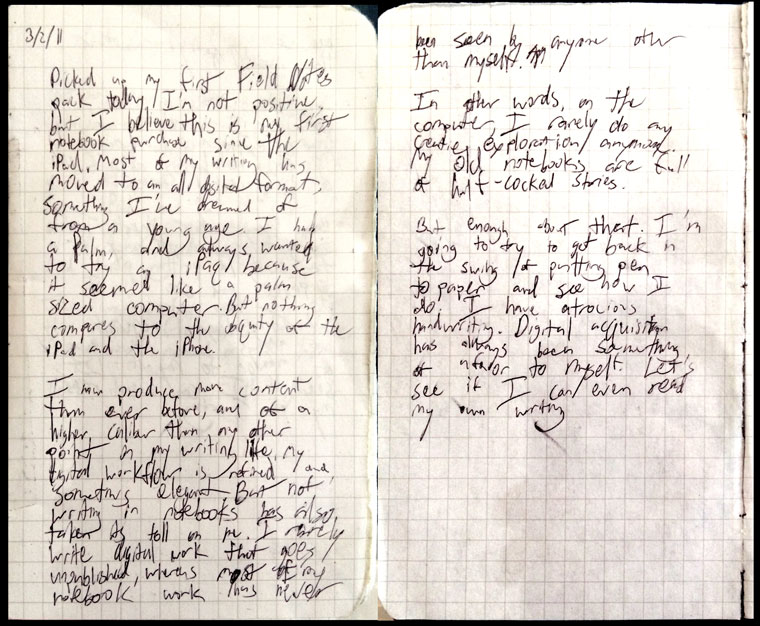
Handwritten Blogging
Two quick editorial notes:
- I checked and I had been producing “more content than ever before” back in 2011; whether it was all that great (ugh, “high caliber,” Jon?) is something I’m scared to go back and adjudicate.
- Remember iPAQs?
-
For the curious here’s the breakdown:
- 14 Sealed Packs (13 3-packs and 1 Arts and Sciences 2-pack)
- 30 Singles
- 30 Full Books
101 books, plus the one I’m using right now. And honsetly I think a few more are hiding around the house… ↩︎
-
I haven’t filled out the inside covers on most of my books, which would have made this process easy. And no, I didn’t fill them out last night either. ↩︎
-
There’s a listing for a sealed Raven’s Wing 3-pack on eBay going for $150, which is high but actually not that much more than many would pay. There were only 15,000 of these books printed. For comparison, the latest “Colors” edition, Workshop Companion, was a run of 102,000 books. It’s not exactly apples-to-apples (there are six unique Workshop books in each box wheras all the Raven’s Wing were the same), but suffice it to say: older editions are scarecer, and collectors are always on the lookout.
Speaking of which, if anyone has a Just Below Zero set they’d like to part with, be in touch. ↩︎
-
I don’t revisit them often, because, as the motto goes: “I’m not writing it down to remember it later. I’m writing it down to remember it now.” ↩︎
Apple Music Connect is Too Good to Waste on Artists

Apple Music Connect
As soon as iOS 8.4 came out last week I downloaded it and signed up for my free trial of Apple Music. Yes, there are some problems, but overall Apple Music is everything I ever wanted in a streaming service. The near-perfect mix of streaming library mixed with music that clearly belongs to me.
I’d like to focus on one of the more maligned features of Apple Music: Connect. Here’s a small sampling of the reactions to Connect out there, starting with Dr. Drang:
This is, to me, the least interesting part of Apple Music because I’m far too jaded to believe that anything put here is straight from the artists themselves.
Walt Mossberg tried to explain it:
[Connect] is a sort of social network for artists to reach their fans; the artists post photos, videos and more, and can receive comments from fans.
Jim Dalrymple wasn’t sure about it, but invoked the name of one of Apple’s biggest black eyes, Ping:
I’m not really sure what to think about Connect, Apple’s service that allows us to follow bands and musicians. To me, it seems a lot like Ping, but we’ll have to see how it works.
And Brian X. Chen at the New York Times devoted an entire article to skewering it:
The weakness of Apple Music is Connect, the social network for musicians, which allows artists to upload media, like postings about their concert dates or album releases. Fans can follow artists and “love” or comment on these posts.
But the artists I followed, like Kings of Leon, Belle and Sebastian and Sonic Youth, used Connect as a portal to upload seemingly arbitrary photos and link to places where people could buy their iTunes albums. And they didn’t appear to be socializing with fans. That’s not a social network; it’s a broadcasting platform.
I actually agree with all of the above. Artists postings thus far have been less than stellar. I think Apple has made a massive mistake billing Connect as a place to follow musicians. Connect is actually a wonderful service being squandered by Apple. The things that Apple is expecting artists to post just aren’t that interesting. Links to their own music and original photos or videos are relatively weak sauce, and the posts have been few and far between for most artists.
However, Connect is great for sharing exactly what I came to the Music app for: music. The trouble is most artists aren’t posting music; they’re promoting themselves in a fairly bland manner. I’ve found the best people to follow are DJs and performers with shows on Beats 1, as well as Apple’s in-house “curators.”1
I follow not only Zane Lowe and Julie Adenuga, but the accounts for “The Pharmacy with Dr. Dre” and “St. Vincent’s Mixtape Delivery Service.” For good measure I started following Apple Music Jazz and Pitchfork.2 These and other accounts have made my Connect tab go from a wasteland to a vibrant, always updated landscape.
The Beats 1 show accounts are great because you can get playlists for a show you missed (or listened to and wanted to revisit). The other curator accounts surface other kinds of music and move that into my Connect feed, where I may end up finding my new favorite song.
Right now anyone can share playlists through Apple Music. However, not anyone can get an account that can be followed. When that happens, I think Connect will be, unabashedly, the best music social network on the planet. The trouble right now is that Apple wants it to be a “a place where musicians give their fans a closer look at their work, their inspirations, and their world.” That’s not an interesting enough proposition.
Connect is dying to be a killer destination on my phone. I hope Apple sets it free soon. When they do, you can bet it will for would-be DJs what Instagram has done for photographers. The next Zane Lowe will be found in Connect, not on the airwaves.
Where to Find Non-Artist Accounts in Apple Music
There are two main places to look.
To find Beats 1 show accounts, go to the Radio tab and tap Beats 1. Scroll down past the “Upcoming Shows” schedule until you hit “Featured Shows.” There you’ll see album art for the current main rotation on Beats 1. Tap on a show and then tap “Follow.”
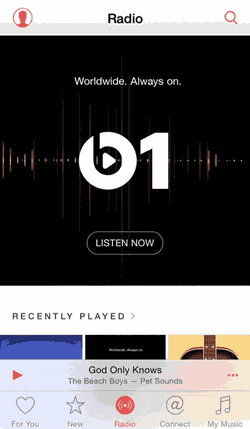
Where to Find Beats 1 Show Accounts
To find Apple’s genre and curator accounts, go to the New Tab and scroll down just a bit. Apple Editors Playlists will show you the accounts for every genre. Curators Playlists will show you accounts for Apple’s launch partner playlist makers. These include Complex, The Fader and other magazines. I hope these accounts will open up to anyone soon. There is so much music within Apple Music to unearth.
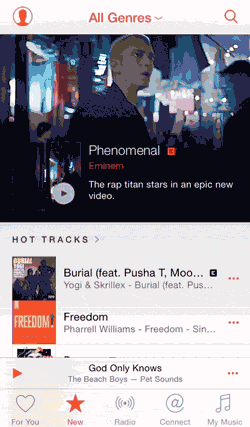
Where to Find Curator Accounts
The Dissolve Shutters
Well this sucks. Keith Phipps, founder of The Dissolve, pens the movie site’s final post:
For the past two years—well, two years this Friday—it’s been our pleasure to put up this site, a site founded on and driven by a love for movies, alongside a company with passion and talent for creating thoughtful, important work. Sadly, because of the various challenges inherent in launching a freestanding website in a crowded publishing environment, financial and otherwise, today is the last day we will be doing that
The Dissolve was an ambitious effort. The pitch, from my outsider’s perspective, was a film site that could stay relevant while operating outside the daily grind of marketing nonsense (“leaked” set photos, regurgitated press releases, et al.). It kills me that they couldn’t make it.
They’ve got helluva stable of incredible film writers looking for work today. Best of luck to everyone.
Running With My Apple Watch

Move Streak
From the moment I first strapped on my Apple Watch, I’ve been diligent to fill all three rings in the Activity app. Though it may seem silly, it felt great when I got the below badge for filling them all every day in the month of June.
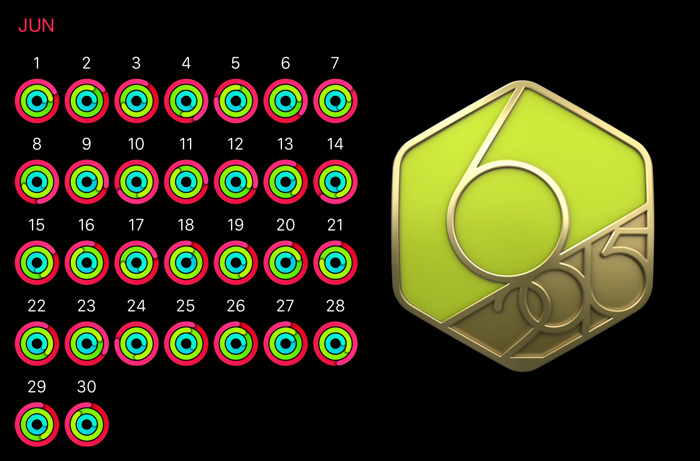
June 2015 Achievement Badge
I still use RunKeeper, which I’ve used to track my runs since October 2013. Rifling through my old running stats, I can see that I’ve gone through quite a few workout spurts over the years. The regimen I’ve kept up these last two months and change is by far my most consistent fitness effort to date.
And it’s working!
Since May I’ve shaved about 90 seconds off my first mile time and 6 pounds off my gut.1 This is after I spent a little over a year trying to lose all the weight I put on eating my way through Texas after I first moved here.
So, is this all because of Apple Watch? I don’t know. Will it last? Who knows. But I can tell you personally that I really, really like my Apple Watch, with this latest burst of fitness perseverance being my most illustrative reason.
I still always run with my iPhone. For one, Apple’s Workout app doesn’t let you retrieve split timings, so I need to rely on RunKeeper for that. Once they add splits I’ll most likely be done with RunKeeper. (Right now I use both apps to track my runs.)
The other, bigger reason I run with my phone is for safety’s sake. It allows me to call for help if I need it and provides emergency contacts for others to help me. While I appreciate the ability to run with only my Apple Watch, I don’t see myself heading out without my iPhone any time soon.2
Some Apple Watch Workout Tips & Tricks
Here are a few things I’ve learned from running with the Apple Watch. Some of these may be obvious or known, but they weren’t to me at first. So I thought I’d share them.
- 6 Second Start
- It takes 6 seconds from the moment you tap “Start” on a workout to the time your Watch actually starts tracking the workout
- If you tap the screen after you hit “Start” it will end the countdown and go right into tracking
- I have a 10 second countdown on RunKeeper runs, which gives me a little leeway to sync RunKeeper and Workout
- Elapsed Time, Distance and Heart Rate on One Screen
- Here’s what I like to see on my watch during a run:
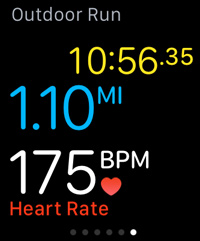
Watch Workout Sample
- Set a distance goal so the middle numbers on the Watch screen will be your mileage
- Swipe the bottom metric all the way to the right to get your live heart rate during your run
- Tap the clock in the top of the workout screen to get your elapsed time to display there
- If you need to know the time, I find it’s easier to just switch back to the watch face (double tap the crown) than cycle through your options on the line
- For reference, here are the options for each row on the workout screen in the order you can cycle through them
- Top row: Current Time, Pace or Elapsed Time
- Middle row displays your goal, either: Calories, Time or Distance. An Open workout will display the elapsed time
- Bottom row: Elapsed Time, Pace, Distance, Calories, Heart Rate
- Here’s what I like to see on my watch during a run:
- Taking the Watch Off Mid-Workout Isn’t All That Bad
- If you want to wipe some sweat out from under the heart rate sensor, just take the watch off to wipe it
- You can pause your run if you want, but it will work and continue timing even if you don’t
- You Can’t Come Back From Accidentally Ending a Workout
- If you accidentally end your workout instead of pausing it, there’s nothing you can do
- Just save the workout and start another one where you left off
- I learned this the hard way when I tried pausing a run to clean the heart rate sensor, which is also how I learned how to do that without pausing (see above)
That’s all I can think of for now. Apple’s Workout app is pretty rudimentary for now. I really hope it gets better because it’s the best Watch running app available today. I haven’t mentioned RunKeeper’s Watch app because it’s not so great yet. The text is hard to read while you’re running, and it’s missing some key metrics, namely heart rate. When watchOS 2 debuts later this year I’m sure RunKeeper will have a chance to give Apple a run for its money…or maybe the other way around.